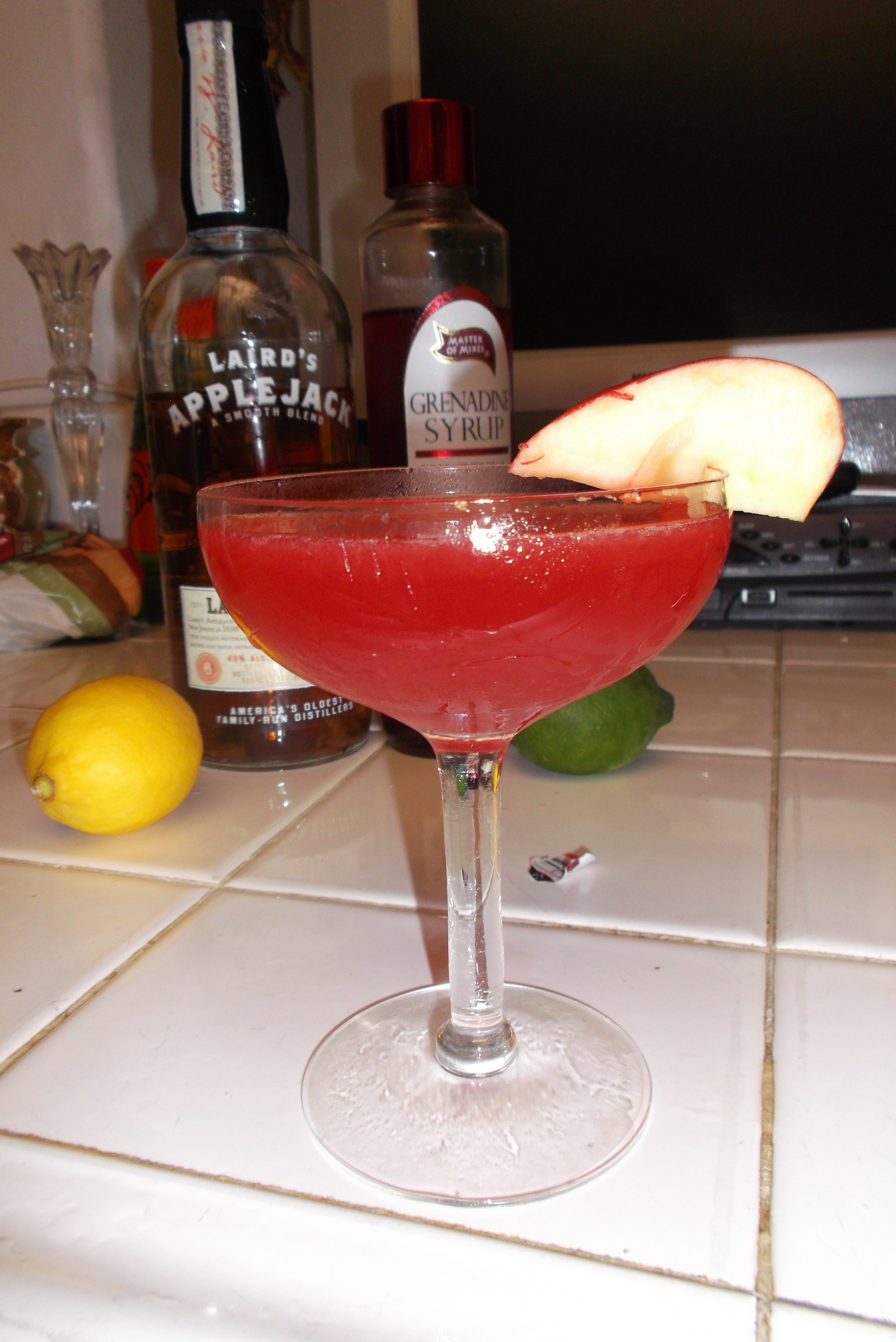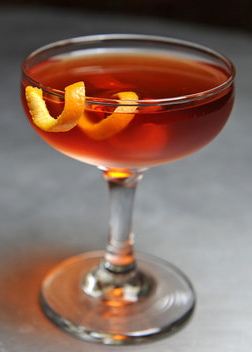Drink of the Week: The Jack Rose
 Considering I’ve never noticed it on a menu, and never tried it myself until about a week ago, there’s a really good chance you’ve never had yourself a Jack Rose. In fact, this once standard drink might now be completely forgotten were it not for assorted mixed beverage historians and its appearance in two famed books: a walk-on in Ernest Hemingway’s ultra-boozy depressive classic, The Sun Also Rises, and a leading role as one of the six basic cocktails featured in David Embury’s 1948 The Fine Art of Mixing Drinks. That Embury could place this now obscure beverage alongside such ur-cocktails as the Daiquiri, the Manhattan, the Old Fashioned, and the Martini indicates that this was once a drink that appeared to have some real staying power.
Considering I’ve never noticed it on a menu, and never tried it myself until about a week ago, there’s a really good chance you’ve never had yourself a Jack Rose. In fact, this once standard drink might now be completely forgotten were it not for assorted mixed beverage historians and its appearance in two famed books: a walk-on in Ernest Hemingway’s ultra-boozy depressive classic, The Sun Also Rises, and a leading role as one of the six basic cocktails featured in David Embury’s 1948 The Fine Art of Mixing Drinks. That Embury could place this now obscure beverage alongside such ur-cocktails as the Daiquiri, the Manhattan, the Old Fashioned, and the Martini indicates that this was once a drink that appeared to have some real staying power.
So, what happened? Well, the Jack Rose is not based on whiskey, gin, or rum but on applejack, which is not a sweet cereal for kids but an American apple brandy that fell into disrepute for decades. I’m here to tell you that both the spirit and the drink are really very good — and it’s likely even better versions are out there. More on that, after the asterisks.
The Jack Rose
2 ounces applejack
1 ounce fresh lime or lemon juice
1/2 ounce grenadine
1 apple slice or cocktail cherry (optional garnish)
Combine the liquid ingredients in a cocktail shaker with plenty of ice. Shake vigorously, strain into a chilled cocktail, and toast the printing press, the Internet, and all other means of storing memories. Now, nothing this good has to die forever.
****
If you’ve had the French apple brandy, calvados, then you’ve had apple brandy but you haven’t had applejack. Brewed in New Jersey’s Monmouth County, Laird’s Applejack is pretty much the only game for what was once an ubiquitous American hard liquor. Apparently, part of the issue was that the traditional method of distilling hard apple cider into the applejack by freezing excess water sometimes had some seriously unfortunate chemical results. Happily, I’ve been enjoying quite a bit of Laird’s Applejack this week without the slightest threat to my life or eyesight. Indeed, I really liked the 80 proof Laird’s I was able to buy for a very reasonable price. A 100 proof version, which is very well reviewed and about $10.00 more per bottle, is theoretically available.
In any case, it’s equally good with lime or lemon juice, but don’t try a Jack Rose with pricey but much better known calvados and think you’re having a Jack Rose — a Jacques Rosé, perhaps, but not a Jack Rose. I found the calvados version of this drink a bit overdone and perfumey. With applejack, it’s a simple, balanced, refreshing drink that goes down as easy as any sophisticated cocktail you’ve ever had. It’s very nice.
I’m sure it’s possible the drink could be more fully bodied and complex with the 100 proof Laird’s. I’m also sure it could be even better with a finer grade of grenadine. Now, you can buy some very high end grenadines or you can do what all the cool cocktail kids are doing and make your own. For us poor and lazy folks, the Master of Mixes grenadine syrup is probably the best choice for about five or six bucks.
Here’s the deal. A really outstanding homemade or gourmet grenadine is mostly just a mixture of pomegranate juice and lots of sugar; most commercial grenadines seem to be a mixture of “natural and artificial flavors” and high fructose corn syrup, Master of Mixes splits the difference with a mixture of pomegranate and cherry juice and a bit of the ol’ high fruc. I’m sure it could be improved upon, but it’s been working pretty beautifully so far in a number of cocktails here.
I know purists like David Wondrich would want me to make my own, and some day I just might. If you look around, there are plenty of recipes online if you’re so inclined — some are tantalizingly simple. However, these posts are largely dedicated to the idea that making really good cocktails at home can and should be very easy. With a decent storebought grenadine and a tasty, inexpensive base spirit all cocktail fiends should check out, the Jack Rose is a great cocktail that you can make in about five minutes at home for, I’m guessing, less than $1.50 per drink. That’s something.
You can follow us on Twitter and Facebook for content updates. Also, sign up for our email list for weekly updates and check us out on Google+ as well.

 If you’re reading “The Sun Also Rises” right now, this may be the drink you want to put you in the apposite booze addled/jaundiced frame of mind. In fact, it was actually invented at the famed Hemingway hang, Harry’s Bar. If you’re going to overdo it the way the characters in the book do, you could do a lot worse.
If you’re reading “The Sun Also Rises” right now, this may be the drink you want to put you in the apposite booze addled/jaundiced frame of mind. In fact, it was actually invented at the famed Hemingway hang, Harry’s Bar. If you’re going to overdo it the way the characters in the book do, you could do a lot worse.








